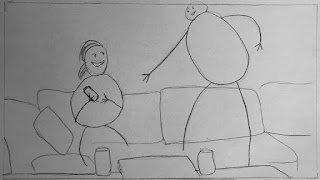Story-Boarding in Filmmaking
Story-Boarding in Filmmaking
Storyboarding is
simply writing out your entire film in comic strip. Scene by scene, from every
angle, and including every movement. Basically so you can watch your whole
movie as a comic strip before starting the actual filming.
You do not have to do this step, many directors choose to just improvise on the spot, but many other legendary ones do it, especially the ones who want the movie to look as close as possible to how they imagined it. Because storyboarding gives you the chance to modify everything that does not look right. Other than that it is a huge time saver, when you have everything planned beforehand, you will not waste valuable time on the set, everything will go smooth and fast. Characters will also have the chance to know how they are supposed to move and how they are supposed to look on screen.
Your storyboard does not have to be perfectly drawn in an artistic way (unless you or one of your crew is an artist), it can be as simple as a kid's drawing as long as everyone in your crew can understand it and gets the point.
You can still give
it afterwards to an artist if you want it to look fancy.
This is how a storyboard template looks like (this is just one way of doing it):
The box represents the frame, the circle is the number of scene, and the lines below are for the description* You will
obviously need as many pages as the number of angles in your film.
To indicate
movement you may use a different color, Red for example, when a character or an
object moves from point A to point B, you can draw a red arrow to indicate
movement in a way that anybody could easily understand.
To indicate camera movement (Pan, Tilt, Zoom,...)on the other hand you can use a different color like blue.
Understand that there is no right or wrong way to storyboard, you can even invent your own way if you want to.
Here is an example:
More on Story-Boarding in filmmaking:
Storyboarding is a pre-visualization technique used in filmmaking and animation to plan out and organize the shots and scenes of a film or animation project. It is a way for the filmmakers to plan and visualize the flow of the story, and to communicate the director's vision to the rest of the crew.
A storyboard is a series of illustrations or images that depict the key shots and scenes of a film or animation project. It's similar to a comic book, where each panel represents a shot or a scene, and the flow of the story is shown through the progression of the panels. The storyboard is usually created by a storyboard artist, who works with the director to plan out the shots and scenes.
The storyboard includes key information such as the composition of the shot, the movement of the camera, the characters in the scene and their actions, the dialogue, and any special effects or visual elements. It also serves as a guide for the filmmakers during the production process, and can be used as a reference for the camera crew, the actors, and the special effects team.
Storyboarding is an essential step in the filmmaking process and it's very useful in the planning and pre-production phase. It helps the filmmakers to visualize the film, identify problems and make changes before they spend a lot of time and money on the production, and it also serves as a guide for the post-production process where the shots and scenes are edited together to create the final film.





















Leave a Comment